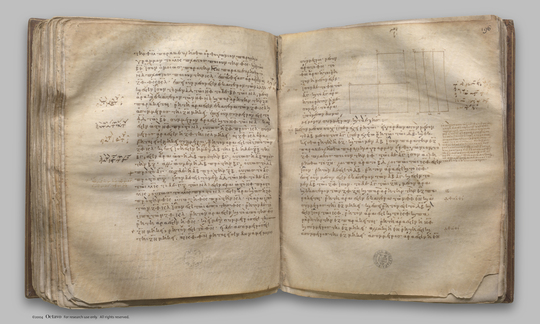index prev next | digilib folio 200

4 medial area does not exceed a medial area by a rational area.
| Μέσον μέσου οὐχ ὑπερέχει ῥητῷ. Εἰ γὰρ δυνατόν, μέσον τὸ ΑΒ μέσου τοῦ ΑΓ ὑπερεχέτω ῥητῷ τῷ ΔΒ, καὶ ἐκκείσθω ῥητὴ ἡ ΕΖ, καὶ τῷ ΑΒ ἴσον παρὰ τὴν ΕΖ παραβεβλήσθω παραλληλόγραμμον ὀρθογώνιον τὸ ΖΘ πλάτος ποιοῦν τὴν ΕΘ, τῷ δὲ ΑΓ ἴσον ἀφῃρήσθω τὸ ΖΗ: λοιπὸν ἄρα τὸ ΒΔ λοιπῷ τῷ ΚΘ ἐστιν ἴσον. ῥητὸν δέ ἐστι τὸ ΔΒ: ῥητὸν ἄρα ἐστὶ καὶ τὸ ΚΘ. ἐπεὶ οὖν μέσον ἐστὶν ἑκάτερον τῶν ΑΒ, ΑΓ, καί ἐστι τὸ μὲν ΑΒ τῷ ΖΘ ἴσον, τὸ δὲ ΑΓ τῷ ΖΗ, μέσον ἄρα καὶ ἑκάτερον τῶν ΖΘ, ΖΗ. καὶ παρὰ ῥητὴν τὴν ΕΖ παράκειται: ῥητὴ ἄρα ἐστὶν ἑκατέρα τῶν ΘΕ, ΕΗ καὶ ἀσύμμετρος τῇ ΕΖ μήκει. καὶ ἐπεὶ ῥητόν ἐστι τὸ ΔΒ καί ἐστιν ἴσον τῷ ΚΘ, ῥητὸν ἄρα ἐστὶ καὶ τὸ ΚΘ. καὶ παρὰ ῥητὴν τὴν ΕΖ παράκειται: ῥητὴ ἄρα ἐστὶν ἡ ΗΘ καὶ σύμμετρος τῇ ΕΖ μήκει. ἀλλὰ καὶ ἡ ΕΗ ῥητή ἐστι καὶ ἀσύμμετρος τῇ ΕΖ μήκει: ἀσύμμετρος ἄρα ἐστὶν ἡ ΕΗ τῇ ΗΘ μήκει. καί ἐστιν ὡς ἡ ΕΗ πρὸς τὴν ΗΘ, οὕτως τὸ ἀπὸ τῆς ΕΗ πρὸς τὸ ὑπὸ τῶν ΕΗ, ΗΘ: ἀσύμμετρον ἄρα ἐστὶ τὸ ἀπὸ τῆς ΕΗ τῷ ὑπὸ τῶν ΕΗ, ΗΘ. ἀλλὰ τῷ μὲν ἀπὸ τῆς ΕΗ σύμμετρά ἐστι τὰ ἀπὸ τῶν ΕΗ, ΗΘ τετράγωνα: ῥητὰ γὰρ ἀμφότερα: τῷ δὲ ὑπὸ τῶν ΕΗ, ΗΘ σύμμετρόν ἐστι τὸ δὶς ὑπὸ τῶν ΕΗ, ΗΘ: διπλάσιον γάρ ἐστιν αὐτοῦ: ἀσύμμετρα ἄρα ἐστὶ τὰ ἀπὸ τῶν ΕΗ, ΗΘ τῷ δὶς ὑπὸ τῶν ΕΗ, ΗΘ: καὶ συναμφότερα ἄρα τά τε ἀπὸ τῶν ΕΗ, ΗΘ καὶ τὸ δὶς ὑπὸ τῶν ΕΗ, ΗΘ, ὅπερ ἐστὶ τὸ ἀπὸ τῆς ΕΘ, ἀσύμμετρόν ἐστι τοῖς ἀπὸ τῶν ΕΗ, ΗΘ. ῥητὰ δὲ τὰ ἀπὸ τῶν ΕΗ, ΗΘ: ἄλογον ἄρα τὸ ἀπὸ τῆς ΕΘ. ἄλογος ἄρα ἐστὶν ἡ ΕΘ. ἀλλὰ καὶ ῥητή: ὅπερ ἐστὶν ἀδύνατον. Μέσον ἄρα μέσου οὐχ ὑπερέχει ῥητῷ: ὅπερ ἔδει δεῖξαι. | 4 medial area does not exceed a medial area by a rational area. For, if possible, let the medial area AB exceed the medial area AC by the rational area DB, and let a rational straight line EF be set out; to EF let there be applied the rectangular parallelogram FH equal to AB, producing EH as breadth, and let the rectangle FG equal to AC be subtracted; therefore the remainder BD is equal to the remainder KH. But DB is rational; therefore KH is also rational. Since, then, each of the rectangles AB, AC is medial, and AB is equal to FH, and AC to FG, therefore each of the rectangles FH, FG is also medial. And they are applied to the rational straight line EF; therefore each of the straight lines HE, EG is rational and incommensurable in length with EF. [X. 22] And, since [DB is rational and is equal to KH, therefore] KH is [also] rational; and it is applied to the rational straight line EF; therefore GH is rational and commensurable in length with EF. [X. 20] But EG is also rational, and is incommensurable in length with EF; therefore EG is incommensurable in length with GH. [X. 13] And, as EG is to GH, so is the square on EG to the rectangle EG, GH; therefore the square on EG is incommensurable with the rectangle EG, GH. [X. 11] But the squares on EG, GH are commensurable with the square on EG, for both are rational; and twice the rectangle EG, GH is commensurable with the rectangle EG, GH, for it is double of it; [X. 6] therefore the squares on EG, GH are incommensurable with twice the rectangle EG, GH; [X. 13] therefore also the sum of the squares on EG, GH and twice the rectangle EG, GH, that is, the square on EH [II. 4], is incommensurable with the squares on EG, GH. [X. 16] But the squares on EG, GH are rational; therefore the square on EH is irrational. [X. Def. 4] Therefore EH is irrational. But it is also rational: which is impossible. |